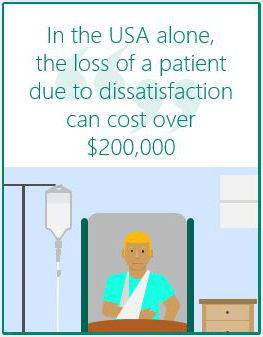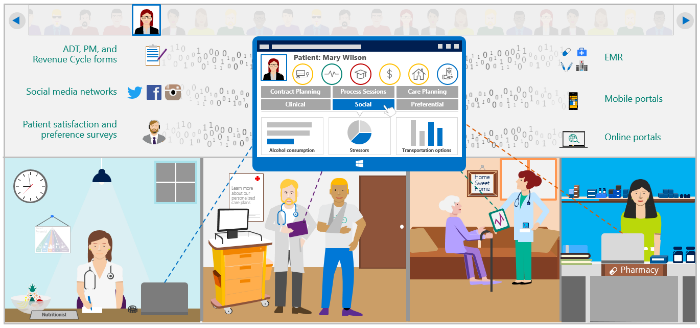
Provide personalization at scale with Health360 Engagement Center
As the use of cloud and digital technologies grow in the healthcare industry, it will transform how healthcare payers, providers, and patients interact with the health system. We are blogging about some of the groundbreaking ways that Microsoft and partner technologies are transforming healthcare. Today’s blog post features Tribridge, a Microsoft partner helping healthcare providers use cloud technology to dramatically improve individual and population health outcomes while reducing costs.
 Dale Carnegie famously said, “a person’s name is, to that person, the sweetest and most important sound in any language.”i It’s a simple idea, but one that resonates with the vast majority of people. Knowing someone by name, or not knowing, changes the dynamic of any interaction. This is important to take in to account when approaching any customer experience, but especially important in healthcare – which is a very personal experience. Patients share their most private information with their care providers, and to have an experience that is so personal feel entirely impersonal causes a huge disconnect for patients, resulting in a very negative experience. The best way organizations can work to provide individualized care, and mitigate this feeling of disconnect, is by implementing a smart connected system. To meet today’s challenges, healthcare organizations need to employ a solution that will help them transform into a digital business.
Dale Carnegie famously said, “a person’s name is, to that person, the sweetest and most important sound in any language.”i It’s a simple idea, but one that resonates with the vast majority of people. Knowing someone by name, or not knowing, changes the dynamic of any interaction. This is important to take in to account when approaching any customer experience, but especially important in healthcare – which is a very personal experience. Patients share their most private information with their care providers, and to have an experience that is so personal feel entirely impersonal causes a huge disconnect for patients, resulting in a very negative experience. The best way organizations can work to provide individualized care, and mitigate this feeling of disconnect, is by implementing a smart connected system. To meet today’s challenges, healthcare organizations need to employ a solution that will help them transform into a digital business.
Meet today’s healthcare challenges
 Effectively storing and accessing patient information is the first step towards gaining the insights and analytics that are key to solving many of today’s most pressing healthcare challenges such as disconnected data, teams, and a lack of insights. Patient information is often housed in numerous separate locations and systems, including static electronic medical record (EMR) systems. These disparate systems from separate practices, businesses, and hospitals do not communicate well with one another. Care teams often find that because of the disconnect they cannot collaborate effectively, impacting the level of personalized care patients receive. Providing patients with personalized care leads to increased satisfaction, retention, and loyalty. In the USA alone, the loss of a patient due to dissatisfaction can cost over $200,000 in income over the lifetime of the practiceii. So how can healthcare providers bridge the gap and provide a more personalized experience?
Effectively storing and accessing patient information is the first step towards gaining the insights and analytics that are key to solving many of today’s most pressing healthcare challenges such as disconnected data, teams, and a lack of insights. Patient information is often housed in numerous separate locations and systems, including static electronic medical record (EMR) systems. These disparate systems from separate practices, businesses, and hospitals do not communicate well with one another. Care teams often find that because of the disconnect they cannot collaborate effectively, impacting the level of personalized care patients receive. Providing patients with personalized care leads to increased satisfaction, retention, and loyalty. In the USA alone, the loss of a patient due to dissatisfaction can cost over $200,000 in income over the lifetime of the practiceii. So how can healthcare providers bridge the gap and provide a more personalized experience?
Utilize an industry leading solution
Tribridge Health360 Engagement Center is an industry leading, cloud-based solution. It enables personalized care experiences based on a foundational, person-centered, healthcare data model, focused on helping patients be well and stay well. It leverages data from EMRs and other information systems to present a 360-degree view of patients. However, unlike an EMR, which only documents care, Health360 Engagement Center has been designed from the ground up as a customer relationship management (CRM) tool, and provides the foundation to personalize interactions and create better overall care experiences for both patients and care providers.
 With Tribridge Health360 Engagement Center, healthcare providers can aggregate data into a single patient file, and centralize disconnected patient information with a single source of truth. With the right security level, this information is accessible in real time, by any care provider, on any device, wherever they are. With a quick glance, providers understand a patient’s entire medical history, behaviors, and preferences.
With Tribridge Health360 Engagement Center, healthcare providers can aggregate data into a single patient file, and centralize disconnected patient information with a single source of truth. With the right security level, this information is accessible in real time, by any care provider, on any device, wherever they are. With a quick glance, providers understand a patient’s entire medical history, behaviors, and preferences.
To ensure patient satisfaction, it is essential to ensure personalized care for every patient. For many health systems that involves unifying records for millions of patients, with thousands of data points for each patient. Tribridge’s solution, built on Microsoft Cloud technology, is designed to handle high volumes of patient records across care locations and organizations. Personalized care is essential as patients are often sharing their most private information with their care providers, regardless of how many millions of patients a healthcare organization may have. This level of personalization improves productivity and patient satisfaction from first point of access.
Finally, healthcare organizations must drive ongoing success. With Tribridge Health360 Engagement Center it is possible to build a powerful, flexible data set that drives new insights. The Health360 Engagement Center enables providers to improve patient care by seamlessly adding on new capabilities over time. One such evolution is Care Coordination, a solution that allows healthcare organizations to engage patients, plan, coordinate, and personalize care to improve population health one person at a time. This ensures healthcare organizations will be able to provide a gold standard of care and differentiated patient experiences.
Get started today
Microsoft and Tribridge can help your organization connect with patients and promote innovation in today’s increasingly digital world. This trusted partnership helps ensure that when your patients share their most private information you can provide a personal and positive experience. Unlock your potential today with the Tribridge Health360 Engagement Center solution. Learn more about the solution and try the preview now on Microsoft AppSource. And this is just the first step. Once treatment data is unified in a single solution, there are analytics solutions that can help you achieve other goals in your organization, like population health management. For more information read the Care Coordination launch blog and learn more on AppSource today.
________________________________________________________________________________________________________________
iHow to Win Friends & Influence People by Dale Carnegie
iiLuecke RW, Rosselli VR, Moss JM. The economic ramifications of “client” dissatisfaction. Group Pract J. 1991:8–18


![[4:56 PM] Jordan Davis (Wipro Designit Services, Inc.) Green background with colored swoops on the top and an image of a young adult helping older adult with a computer.](https://www.microsoft.com/en-us/industry/blog/wp-content/uploads/2024/04/MSFT_Azure_APR08_328468_Blog_Blogheader_240408_V01-1-300x169.webp)

